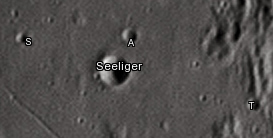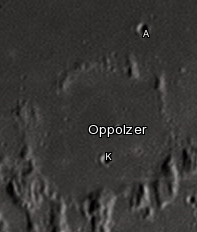|
Sinus Medii
Sinus Medii (Latin ''sinus mediī'' "Middle Bay") is a small lunar mare. It takes its name from its location at the intersection of the Moon's equator and prime meridian; as seen from the Earth, this feature is located in the central part of the Moon's near side, and it is the point closest to the Earth. From this spot, the Earth would always appear directly overhead, although the planet's position would vary slightly due to libration. During the Apollo program, Sinus Medii was designated Apollo Landing Site 3 (ALS3). Flight operations planners were concerned about having the optimum lighting conditions at the landing site. Hence, alternative landing sites moved progressively westward, following the terminator. A delay of two days for weather or equipment reasons would have sent Apollo 11 to Sinus Medii instead of ALS2, Mare Tranquillitatis (where it actually landed); another two-day delay would have resulted in ALS5, a site in Oceanus Procellarum, being targeted. Geology The ... [...More Info...] [...Related Items...] OR: [Wikipedia] [Google] [Baidu] |
Lunar Reconnaissance Orbiter
The Lunar Reconnaissance Orbiter (LRO) is a NASA robotic spacecraft currently orbiting the Moon in an eccentric Polar orbit, polar mapping orbit. Data collected by LRO have been described as essential for planning NASA's future human and robotic missions to the Moon. Its detailed mapping program is identifying safe landing sites, locating potential resources on the Moon, characterizing the radiation environment, and demonstrating new technologies. Launched on June 18, 2009, in conjunction with the LCROSS, Lunar Crater Observation and Sensing Satellite (LCROSS), as the vanguard of NASA's Lunar Precursor Robotic Program, LRO was the first United States mission to the Moon in over ten years. LRO and LCROSS were launched as part of the United States's Vision for Space Exploration program. The probe has made a 3-D map of the Moon's surface at 100-meter resolution and 98.2% coverage (excluding polar areas in deep shadow), including 0.5-meter resolution images of Apollo landing sites. ... [...More Info...] [...Related Items...] OR: [Wikipedia] [Google] [Baidu] |
Mare Vaporum
Mare Vaporum (Latin ''vapōrum'', the "sea of vapors") is a lunar mare located between the southwest rim of Mare Serenitatis and the southeast rim of Mare Imbrium. It was named by Giovanni Battista Riccioli in 1651.''Autostar Suite Astronomer Edition''. CD-ROM. Meade, April 2006. The mare lies in an old basin or crater that is within the Procellarum basin. It is in diameter and in area, and is bordered to the northeast by the mountain range Montes Apenninus. In the south of the mare is Rima Hyginus, a rille intersected by the crater Hyginus. The lunar material surrounding the mare is from the Lower Imbrian epoch, and the mare material is from the Eratosthenian The Eratosthenian period in the lunar geologic timescale runs from 3,200 million years ago to 1,100 million years ago. It is named after the crater Eratosthenes, which displays characteristics typical of craters of this age, including a surface ... epoch. References External links Mare Vaporum at The Moon ... [...More Info...] [...Related Items...] OR: [Wikipedia] [Google] [Baidu] |
Rima Oppolzer
Rima, also known as Rima the Jungle Girl, is the fictional heroine of W. H. Hudson's 1904 novel '' Green Mansions: A Romance of the Tropical Forest''. In it, Rima, a primitive girl of the shrinking rain forest of South America, meets Abel, a political fugitive. A film adaptation of '' Green Mansions'' was made in 1959 starring Audrey Hepburn. In 1974, the character was adapted into the comic book ''Rima the Jungle Girl'', published by DC Comics. Though ''Rima the Jungle Girl'' ceased publication in 1975, the comic book version of Rima appeared in several episodes of Hanna-Barbera's popular Saturday morning cartoon series, '' The All-New Super Friends Hour'', between 1977 and 1980. Novel Like her literary cousins Tarzan and Mowgli, Rima sprang from an Edwardian adventure novel; in her case, '' Green Mansions: A Romance of the Tropical Forest'', by W. H. Hudson, published in 1904. Hudson was an Argentine-British naturalist who wrote many classic books about the ecology of Sou ... [...More Info...] [...Related Items...] OR: [Wikipedia] [Google] [Baidu] |
Rima Flammarion
Rima, also known as Rima the Jungle Girl, is the fictional heroine of William Henry Hudson, W. H. Hudson's 1904 novel ''Green Mansions, Green Mansions: A Romance of the Tropical Forest''. In it, Rima, a Jungle girl (stock character), primitive girl of the shrinking rain forest of South America, meets Abel, a political fugitive. A film adaptation of ''Green Mansions (film), Green Mansions'' was made in 1959 starring Audrey Hepburn. In 1974, the character was adapted into the comic book ''Rima the Jungle Girl'', published by DC Comics. Though ''Rima the Jungle Girl'' ceased publication in 1975, the comic book version of Rima appeared in several episodes of Hanna-Barbera, Hanna-Barbera's popular Saturday morning cartoon series, ''The All-New Super Friends Hour'', between 1977 and 1980. Novel Like her literary cousins Tarzan and Mowgli, Rima sprang from an Edwardian adventure novel; in her case, ''Green Mansions, Green Mansions: A Romance of the Tropical Forest'', by William Henry Hu ... [...More Info...] [...Related Items...] OR: [Wikipedia] [Google] [Baidu] |
Seeliger (crater)
Seeliger is a relatively small lunar impact crater that lies near the southeastern edge of Sinus Medii. It was named after the German astronomer Hugo von Seeliger. This is a circular, cup-shaped feature that has not been appreciably worn by impact erosion. To the southeast is a rille named the Rima Réaumur, following a line to the northwest. In the north is the 110-km-long Rima Oppolzer, which divides the mare A mare is an adult female horse or other equidae, equine. In most cases, a mare is a female horse over the age of three, and a filly is a female horse three and younger. In Thoroughbred horse racing, a mare is defined as a female horse more th ... where Seeliger is situated from the remainder of the Sinus Medii. Satellite craters By convention these features are identified on lunar maps by placing the letter on the side of the crater midpoint that is closest to Seeliger. References * * * * * * * * * * * External linksSeeliger at The Moon Wiki{{Comm ... [...More Info...] [...Related Items...] OR: [Wikipedia] [Google] [Baidu] |
Réaumur (crater)
Réaumur is the remains of a Lunar craters, lunar impact crater located on the southern edge of Sinus Medii. Its diameter is 51 km. It was named after the 18th century French scientist René Antoine Ferchault de Réaumur, René de Réaumur. It shares an eroded rim with the similar crater Oppolzer (crater), Oppolzer to the northwest. It lies to the northwest of the large walled plain Hipparchus (lunar crater), Hipparchus, and east of Flammarion (lunar crater), Flammarion. To the south is Gyldén (crater), Gyldén, and farther to the south-southwest is Ptolemaeus (lunar crater), Ptolemaeus. The rim of Réaumur is heavily eroded, and the northern half consists of little more than a series of low ridges in the Lunar mare, mare. The southern rim is notched and indented by small crater impacts. The interior floor is relatively smooth and flat with no significant features. The broken northern rim intersects a rille designated Rima Oppolzer. This feature is about 110 kilometers lon ... [...More Info...] [...Related Items...] OR: [Wikipedia] [Google] [Baidu] |
Oppolzer (crater)
Oppolzer is the remnant of a lunar impact crater that is located on the southern edge of Sinus Medii, along the meridian of the Moon. Its diameter is 41 km. It was named after the Austrian astronomer Theodor von Oppolzer. It is located within one crater diameter of the origin of the selenographic coordinate system at 0° N, 0° W. Attached to the surviving remnants of the southeast rim is the crater Réaumur. To the west-southwest is the lava-flooded walled plain Flammarion. This formation consists of little more than an irregular arc of mounts along the south, and a ring of scattered ridges along the northern rim. There is a particularly wide gap in the rim to the northeast where no ridges survive to mark the crater perimeter. The interior floor has been resurfaced by basaltic lava. A 110-km-long rille Rille (German for 'groove') is typically used to describe any of the long, narrow depressions in the surface of the Moon that resemble channels. The Latin ter ... [...More Info...] [...Related Items...] OR: [Wikipedia] [Google] [Baidu] |
Flammarion (lunar Crater)
Flammarion is a Lunar craters, lunar impact crater on the south edge of Sinus Medii. Its diameter is 76 km. It is named after the French astronomer Camille Flammarion. It is located between the crater Mösting (crater), Mösting to the northwest and Herschel (lunar crater), Herschel to the southeast. The bowl-shaped Mösting A intersects the western rim of Flammarion. The worn outer wall of Flammarion is broken in the northwest, and the remainder is eroded and damaged. The most intact section of the wall lies to the southeast. A rille designated Rima Flammarion lies across the gap in the northwest rim, extending about 80 kilometers to the west-southwest. The crater floor has been flooded by lava, and is relatively smooth with only a few scattered craterlets to mark the surface. Satellite craters By convention these features are identified on lunar maps by placing the letter on the side of the crater midpoint that is closest to Flammarion. See also * Flammarion (Mart ... [...More Info...] [...Related Items...] OR: [Wikipedia] [Google] [Baidu] |








